Movies & TV / Columns
Grace Roebuck On Co-Directing Lucky Louie, Working Alongside Her Father
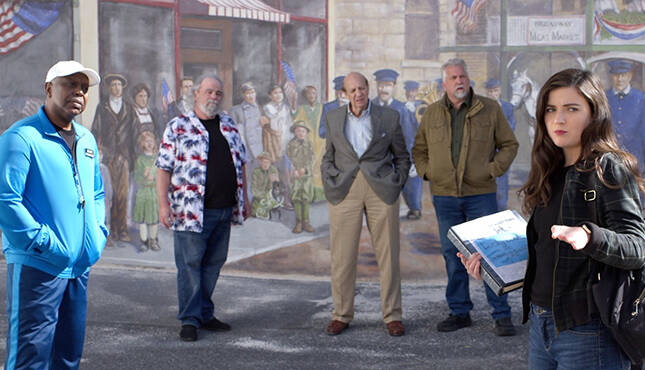 Image Credit: A Channel of Peace
Image Credit: A Channel of Peace
The 411 Interview: Grace Roebuck
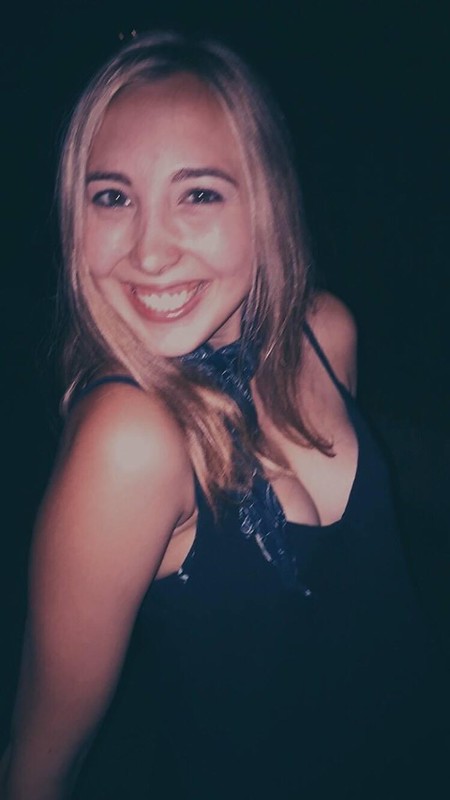
Grace Roebuck is a writer, actor, producer, and director who has been working in the entertainment business since, according to her imdb page, at least 2013. Roebuck has appeared in Dr. Shocker’s Halloween Spooktacular and Christmas is Here Again and worked on the crew of such movies as the short Like Last Night and the feature film Getting Grace. Roebuck’s first effort as a director and writer is the family comedy Lucky Louie, which she co-wrote and co-directed with her father Daniel Roebuck (he also stars in the movie). In this interview, Grace Roebuck talks with this writer about co-directing Lucky Louie, working with her father, and more.
**
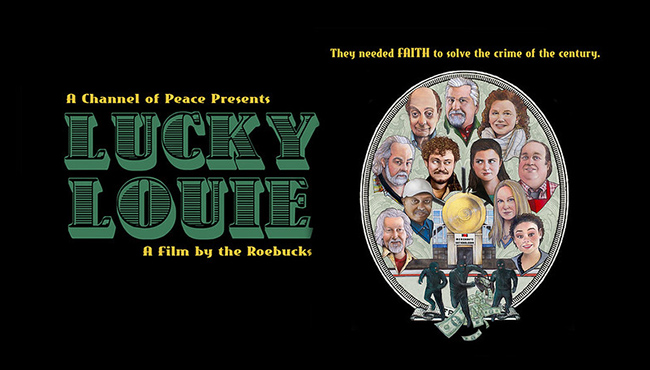
Bryan Kristopowitz: Why did you want Lucky Louie to be your first movie as a director?
Grace Roebuck: It’s a great gift to have been able to do this beside my father. Directing is something I will always cherish and love doing, but it is a job that takes a great deal of education and time to learn. Making my first film with my dad was special because even though I was so green, I felt very safe doing it with him. I also had the perfect environment to work and learn in. I was surrounded by a multitude of people who would answer my endless questions, give me guidance, and collaborate with me to bring an idea to fruition. I proudly lean on my crew, and am deeply grateful to grow with them.
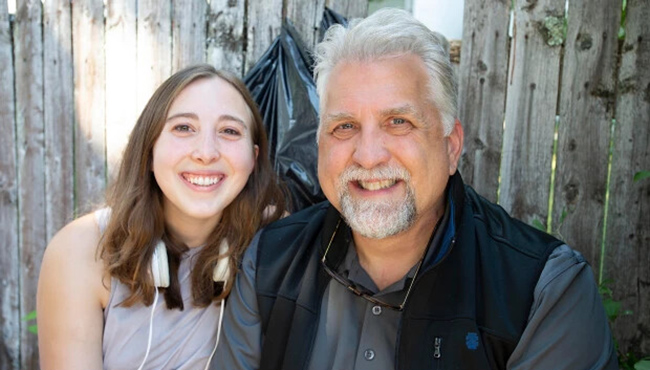
BK: What was it like working with your father Daniel Roebuck as your co-director and star of the movie? What sort of “directing arrangement” did you have with him?
GR: The only arrangement that really was decided ahead of time was that I would obviously be the one to call “action” and “cut” when my dad was performing in the scene. Other than that, we really just took turns taking the lead. It was all very organic, and we both thought about it much less than we had each anticipated. I am thankful to have such an uncomplicated rhythm with him. It definitely adds an extra layer of fun and ease to it all.
BK: Where was Lucky Louie made?
GR: The beautiful state of Pennsylvania. Both my parents are from Bethlehem, PA and I spent every summer there growing up. We have made three films in the Lehigh Valley. It’s such an extraordinary place and it has been a privilege to share its beauty and magic with everyone.
BK: How did you cast Lucky Louie?
GR: We are very fortunate to know so many great actors, so when my father and I write we often create and write parts with specific individuals in mind (Basil Hoffman as Wilbert and Madelyn Dundon as Alex, for example). For Lucky Louie, we had already cast many of the leads by the time we finished the script. However, we did hold auditions in the Lehigh Valley for any remaining characters where we found amazing talents to fill our screen.
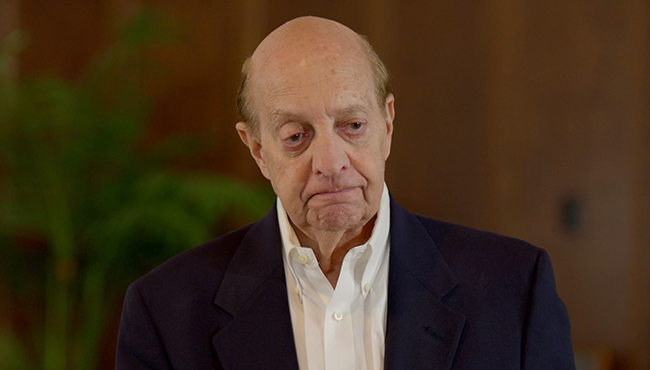
BK: How long did it take to make Lucky Louie, from finishing the script to completing post-production?
GR: It only took about a month and a half to complete the script with my father. He originally pitched me the story in June 2020, we began writing in July, and we were shooting by September. As rapid as pre-production and filming was, post-production did take longer because of many circumstances, (my dad traveling to shoot The Munsters, filming of The Hail Mary, etc.) and was not complete until late winter/ early spring 2023.
BK: What was the hardest part of making Lucky Louie for you, as a director? What was the easiest?
GR: While not necessarily difficult, the component that took maybe the most energy was that it was my first experience directing anything of this proportion, so there were many, many things to discover and learn. Also, keeping all the timelines straight was a challenge we faced because the story had different versions of characters. Many characters were ‘played’ by three different people (1970s, present day, and the reenactment), so that took a lot of focus and organization.
The easiest part is not only working with my dad, but with a cast and crew that make my job so easy. Everyone shows up and does outstanding work that constantly leaves me speechless and ready for more. I’ve worked beside a majority of these people for so many years, and it just keeps getting better.
BK: Was it difficult to find all of those classic cars for the scenes set in 1972? Where did they all come from? Did you have a favorite old car?
GR: There is an awesome community of people in the area who love and own these vintage cars, and they graciously allowed us to utilize them for filming. They add such an authentic quality to all the 1970s scenes, not to mention how vibrant and cool they all are. I admired all of them, each for different reasons. It was sad to say farewell to the Corvair -the getaway car- because my dad and I were tasked with driving it home several nights, and we had some extra time with that one.
BK: How did you establish the tone and pleasant rhythm of the movie? Was it something that was there in the script from the get go or was it something that you had to sort of figure out while making the movie?
GR: We knew we wanted to create something family-friendly and fun! We had the utmost confidence our performers would help us get there, with the joy and laughter. Since the actual bank robbery and closing scenes are heavier ones, we did our best to integrate a lot of jokes and lightness into the rest of the movie. For instance, we knew we wanted the bank robbery reenactment to be silly and playful, and that helped maintain the film’s sweet rhythm.

BK: How do you balance the message of your movie with the plot you’re using/the story you’re telling? How do you avoid “being preachy” while still making a movie with a message/viewpoint?
GR: It is important to us, as filmmakers, that at the end of the day we are making something that anyone could see and enjoy without feeling like there is any kind of hidden agenda. We put a great deal of thought into our storylines and dialogue. And we hope the messages that are embedded feel appropriate and just, and that it seamlessly intertwines with our stories. I do think the care and attention we put into those decisions attribute to what I hope is an entertaining movie for all.
BK: Any moviemaking heroes?
GR: This is always a tricky one to answer. One of my favorite storytellers is the late and great Jean-Marc Vallée. He had such a unique directing and editing style that was always flawless and surprised you as a viewer. He told such raw, tender, moving stories that would stay with me for a long time after I watched them. It is devastating that he is gone, but I know he has impacted me, along with many other filmmakers in so many ways. When I want to be inspired, I re-watch his films and shows.
BK: Any upcoming projects you can tell us about?
GR: Down the line I have two films that I produced! The Hail Mary is a football epic made through A Channel of Peace, the same non-profit that made Lucky Louie. And then there is something a little different– a gambling thriller called Tuesday’s Flu that my father directed. When I am not directing or producing (or working at a restaurant) I try to write as much as possible, to always have something in my portfolio. I have been busy working on a mini-series and a screenplay, both have elements of mystery; I can’t stay away!
BK: What do you hope audiences get out of Lucky Louie?
GR: I really hope viewers like the mystery embedded in it. We did our best to emulate a classic “Whodunnit?” and spent a lot of time studying and educating ourselves on the classics. I am always honored when people make the time to see our movies, and it feels so rewarding when they enjoy the films we make. I also love the message in our movie that it’s never too late to ask for forgiveness.

BK: Is Barney’s Café a real place? Where did all of the pies and desert come from?
GR: We used a location that used to be a diner in Bethlehem. Our amazing art department transformed it into Barney’s Cafe. It’s amazing what they were able to pull off in such a short amount of time. A fantastic artist, Shannon, came in and painted that beautiful mural showcasing Pennsylvania’s beauty around the room. That mural is one of my favorite details of the movie.
There were a couple fake food props we put in the display case. Our team gathered the other cakes and pies from stores, and then made them look even more delectable. I remember always craving something sweet while shooting those scenes at Barney’s!
BK: Who is a bigger fan of Donald Duck, you or your father?
GR: After this, Donald Duck and his nephews have a perpetual place in our hearts. There’s a line in Lucky Louie about how special it was when The Wonderful World of Disney was playing a Donald Duck cartoon. Both my father and I enjoyed watching those during our respective childhoods.
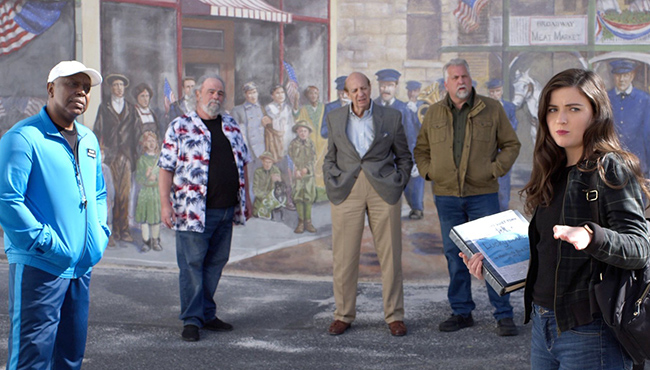
**
A very special thanks to Grace Roebuck for agreeing to participate in the interview and to david j. moore for setting it up.
Check out the official A Channel of Peace website here and Facebook page here! Check both of these pages for updates on Lucky Louie’s release schedule (both theatrical and digital).
Grace Roebuck image courtesy of Grace Roebuck. All other images courtesy of A Channel of Peace.







